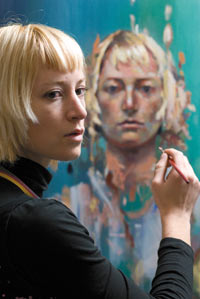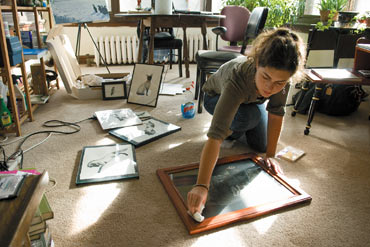Sale showcases student potential, affordable art
With artwork displayed everywhere from the Class of 1925 Gallery to Wisconsin Union art galleries director Robin Schmoldt’s office, the Wisconsin Union has been well-known for its support of the arts over the years.
“We’re able to display about two-thirds of the collection at any given time,” Schmoldt says. “Both Memorial Union and Union South, in the hallways, the meeting rooms, anywhere that we can display it, the offices — those are all permanent collection pieces. The Wisconsin Union was one of the first places to really make an emphasis on art being an every-day part of peoples’ lives, and we really live it by putting original art on the walls.”
The unions’ ties to the art world include their support of UW–Madison’s student artists, with much of the work displayed in each union building coming from students. This support, however, isn’t limited to just displaying art. The Wisconsin Union Directorate Art Committee also organizes two events: one juried show in the spring, and a sale in the fall.

Stopping to look at her reflection in an adjacent mirror, graduate student Katelyn Alain works on a self portrait in her studio space in the Mosse Humanities Building. Alain is one of several students participating in the annual Student Art Sale, to be held Nov. 14–16 at the Porter Butts Gallery in the Memorial Union. Alain will be selling reproductions of her large-scale portraits and figure studies.
Photo: Jeff Miller
The Student Art Sale was revived on campus in 2003 and 2004, Schmoldt says, as students on the WUD Art Committee sought to professionalize the event and draw in more student artists.
Christena Gunther, a UW–Madison graduate now earning her master’s degree in visual arts administration at New York University, served as the director of the WUD Art Committee from 2004–06. In those years, she says the committee began preparing for the art sale further in advance, advertising more to students and the public to increase the size of the sale — including targeting nonart majors for their artwork — and expanding the hours of the sale to allow more people to attend.
“The most challenging aspect of the sale in 2004 was ensuring that we had an efficient sales-tracking method,” she says. “Since we are staffed by art committee volunteers in two-hour shifts, it was hard to make sure things didn’t fall through the cracks. Additionally, it’s very challenging to keep track of what each artist earned.”
With the help of Schmoldt, she says, the committee was able to create a system that worked well and made participating easy for student artists. In 2003, the event sold $300 in student artwork, and by 2006, that number was up to $1,500, a “nice trajectory of growth,” Schmoldt says.
Schmoldt, who advises the Art Committee, adds the sale is a good opportunity for both artists and local consumers. For student artists, the sale offers a forum to display and sell artwork that requires little input in terms of time, and takes only a small commission on their sales to cover the costs of the show.
“It’s an opportunity for us to give those students a taste of selling artwork and getting a feel for the business side of things, but in sort of a safe, nurturing environment,” she says. “What they need to do for administration is pretty minimal, and we allow them to set their own prices so there’s not a huge commission bump-up.”

Michelle Bridwell, a senior pursuing an undergraduate degree in art education, cleans matted and framed artwork in her Madison apartment.
Photo: Jeff Miller
For visitors to the sale, Schmoldt says, the show provides the perfect place for holiday shopping. Students often price their artwork affordably, and sometimes a $50 purchase can become an investment as students continue in their art careers. One example of this is the Union’s purchase of an early Bruce Nauman piece in the 1960s. Nauman, a science major at UW–Madison at the time, went on to become one of the most well-known modern artists of the last few decades.
The Nauman painting, Schmoldt says, spends most of its time in storage due to wear and tear causing paint damage, but it was recently brought out for a student-curated show in the spring. The Union also displays an early glass sculpture from Dale Chihuly, who attended graduate school at UW–Madison.
While these are just a few examples, pieces like these illustrate the strength of UW–Madison’s art department, Gunther says, and the high quality of artwork produced by its students.
“UW–Madison is known nationwide for its art department, particularly for its printmaking,” she says. “All of my peers at NYU are aware of and comment on UW–Madison’s excellent standing in art. The Student Art Sale customers are purchasing high-quality work at an affordable price, which is a win-win for all involved.”
A look at past and present exhibitors
Katelyn Alain, in her final year in the art graduate program, is no stranger to the business side of art. After graduating from the Hartford Art School in Connecticut, Alain worked to get her pieces into various venues — from juried exhibitions to gallery shows — before entering graduate school.
“Maybe because I’m a little older or feel like I’ve been doing it a long time, I’ve just set myself up in a different way. It’s important to me to try to make money doing this,” she says.
In addition to art shows, the Internet has been a prominent factor in Alain’s career. From her personal Web site to online galleries such as Saatchi Online, Alain sells her work from a number of online venues. Alain’s most recently sold work, a painting titled “The Girl in the Red Tunic,” was featured in an Oct. 10 Wall Street Journal story on online art galleries, which generated a wave of interest in her artwork.
“I had a ton of calls and e-mails come in asking about my work and how much does it cost to send to Manhattan — I was overwhelmed that first week when it came out. I was like, ‘I’m not prepared for this!’” she says, laughing.
While the Wall Street Journal and online galleries can help her sell big-ticket items — Alain’s paintings sell for more than $1,000 — Alain says she has enjoyed participating in the Student Art Sale as well, and plans to feature prints as well as studies — which are smaller oil paintings used to plan out major pieces — in this year’s show. Alain’s work focuses primarily on figure and representational paintings, including portraits.
After graduation in May, Alain says she plans to move to Los Angeles and continue pursuing a career in art.
“L.A. is really a good place for young artists right now because there are a lot of new galleries opening up looking for new, younger artists. It’s a little less established than New York, so it’s sort of an up-and-coming scene that’s a good place to be, so I’m going to try it out.”
Melanie Kehoss, who last exhibited in the Student Art Sale in 2005, is a 2007 graduate of UW–Madison’s master of fine arts program. After hearing about the sale through a mass e-mail, Kehoss says the low commission and ease of the sale attracted her to exhibit in it.
“I’ve always been the type of person who applies for every opportunity that comes my way if I think it’s feasible, and so it was just a natural thing like, ‘Yes, I’ll do that. Why not?’” she says.
Kehoss, whose work progressed from paintings into primarily paper cuts, has participated in local art events such as the UW Print Club’s art sales and the Madison Open Art Studios, and she currently has a show at the Forza Gallery on East Johnson Street. While she tends to show her work in galleries first, she noted that galleries take a large commission — up to 50 percent — that art sales do not.
Since graduation, Kehoss has also focused on public art, including a project to decorate the Capitol Square bus shelters over the summer before they were torn down. She is currently working on a public art proposal for Madison’s Burr-Oaks neighborhood, which she recently presented to the Madison Arts Commission.
“My work deals a lot with interaction in public spaces, so it’s a natural thematic progression,” she says. “Also, I think that public art is the best way to get a ton of exposure and to do experimental work that doesn’t rely so much on selling in a gallery situation, and that it’s more art for the community.”
For Michelle Bridwell, a senior in the undergraduate art education program, the Student Art Sale last year provided an easy way to get back into the practice of showing her art after competing in several events and shows in high school.
“In college, I haven’t really done as much, though, because I haven’t had time. Last year was the first time I really started doing anything again, and the sale was kind of getting me back into that,” she says.
Bridwell says participating in the sale was easy — students priced their own work, dropped it off one to two days before the sale, filled out the required paperwork and then sat back and watched their art sell.
“You do have to prep things ahead of time so that they’re ready to sell, but once you get there, it’s really easy,” she says. “I used to go and check and see how many of mine had sold, and it was kind of fun to keep running in and out see what everyone else had, too.”
At the time, Bridwell was experimenting with a new watercolor technique, and she was able to quickly produce the pieces and sell them at reasonable prices at the sale. Bridwell also works with oil paint, chalk pastels and charcoal, producing representational and historical reinterpretation pieces, many of which feature animals. Her watercolor works, which she plans to feature prominently in this year’s sale as well, often feature birds.
“The birds were the first thing that, when I came up with this watercolor series, that I really got into because they’re really easy to draw gesturally and you get a lot of movement with them, and watercolor, when it dries a lot of times has a texture that’s reminiscent of feathers,” she says. “It’s also nice that a lot of other people are interested in birds, and they tend to buy the birds.”
In addition to her watercolors, Bridwell says she plans to sell some of her earlier works from college.
After graduation in May, Bridwell says she hopes to stay in central Wisconsin, teach during the school year and focus on her own art in the summers.
Tags: arts, events, student life, Wisconsin Union

